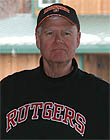|
|
This topic comprises 5 pages: 1 2 3 4 5
|
|
Author
|
Topic: Changovers: Tips and Tricks
|
|
|
Mitchell Dvoskin
Phenomenal Film Handler

Posts: 1869
From: West Milford, NJ, USA
Registered: Jan 2001
|
 posted 07-12-2004 01:36 PM
posted 07-12-2004 01:36 PM




Presentation may have been an art, but changeovers were just mechanics.
- Reels would be threaded with the number "8" in the aperture ("6" for "tv" clock leader).
- Near the end of a reel, a bell driven by centrifical force on the back side of the feed reel spindle would ring to alert the projectionist.
- The projectionist would then light the carbon arc lamp and wait for the first set of cue marks to appear in the top right corner of the picture.
- Upon seeing the first cue marks, the projectionist would start the next projector, open the lamp house dowser, and watch for the second set of cue marks.
- Upon seeing the second set of cue marks, the projectionist would (in most theatres) press the floor petal switch which would open the zipper on one projector and close it on the other. At the same time, he would hit a button on the wall that would switch the sound between machines.
- Then the projectionist would walk over to the other machine and turn off the lamp, close the dowser, and shutoff the projector motor.
It wasn't very hard, you just had to be alert and carefull.
| IP: Logged
|
|
Brad Miller
Administrator

Posts: 17775
From: Plano, TX (36.2 miles NW of Rockwall)
Registered: May 99
|
 posted 07-12-2004 01:44 PM
posted 07-12-2004 01:44 PM




quote:
Lately I've been getting really interested in the golden days of cinema, back when the plots were fresh, the picture was warm and the presentation was perfect.
Andrew, remind me to slap you whenever we meet. Running a changeover is nothing more than knowing what frame of the leader to cue up to and pressing a few buttons upon seeing marks on the film. Basically, a human robot. It's nothing that a machine cannot do just as good and 99% of the time better, with more accuracy. The die hard changeover guys will want to disagree, saying some babble like how they are part of the "art" of the show, but all they are is a human robot and it gives them something to do to help pass the time. It does not add to the final presentation on screen. It's just another way to run the show, much like running a film off of a tower or a platter.
The only "art" that a projectionist can add to a show is in the little things, such as the timing of lighting, curtains, fader control, etc. However that falls under the term "presentation", and can also be done just as well and with more accuracy and consistency by a machine. With the equipment options available to us today, the "presentation" becomes moreso an issue of the quality of the picture and sound, whether that's talking about running film cleaners, keeping the lamphouse tweeked, etc. Things like lighting and curtains would be programmed into the automation so they run perfectly every time without fail.
With today's projection equipment options, choices in sound equipment, better screen surfaces, better lenses, advances in acoustical knowledge, vastly superior film stocks, film cleaners, etc. anyone who thinks that the presentation was better back in the old days is a nut. The best options available many years ago vs. the best options available today proves that it is a technical impossibility.
| IP: Logged
|
|
|
|
|
|
Stephen Furley
Film God

Posts: 3059
From: Coulsdon, Croydon, England
Registered: May 2002
|
 posted 07-12-2004 02:37 PM
posted 07-12-2004 02:37 PM




Andrew, changeovers are simple to do, you just need a bit of practice to get the timing right. I'm not sure what you mean by 'how to perfectly thread up the other projector'. Do you mean which frame you need to have in the gate? If so, it depends on two things, how fast you react and press the start button, and how fast the incomming projector runs up to speed. It will be different for each projectionist, and for different projectors. Sometimes one projector of a pair will even be different to the other, and will require the film to be laced up on a different frame. At the place where I've been projecting recently I normally have to lace up two frames before the '8', you just have to practice to get the timing right.
The leader of a film is 12 feet, or 8 seconds, or 192 frames long; if you start at the 'picture start' frame and count the frames, the first frame of picture will come 192 frames later. The end of a reel of film, from the first frame of the motor cue, to the last frame of picture, is also 192 frames, so if you could react instantly, and the projector could reach full speed instantly, you could lace up on the 'picture start' frame, but since both of these things take time, if you did this, by the time the last frame of the outgoing reel was projected, the incomming reel would still be somewhere in the leader, rather than at the first frame of picture. You therefore need to wind down the incomming reel, so that there will be a shorter length of leader to run through. If you lace up too early in the leader, there will be black frames projected, if you lace up too far down there will be an overlap in time between the end of one reel and the beginning of the next, and some frames will not be seen. In practice, it is not possible to make a perfect changeover, so you lace up to give just a few frames overlap between the reels at the point of changeover. Providing you press the changeover button during these few frames no black frames will be projected, and just a few frames will be missed.
You need to press the start button as soon as you see the motor cue, but don't try to develop a lightening-fast reaction, what matters is to be consistant in your timing. It doesn't matter if your reaction is a bit slow, as long as it's always the same, you will just need to wind the film down an extra frame of two when you lace up.
From the first frame of the changeover cue to the end of the reel is one second, you just get a feel for how long you have to wait from seeing the cue to pressing the button. If you're early you will project the last few frames of leader, which should be black, and if you're late you will project a few frames of black, or possibly one of those 'LFOA' markings, on the end of the outgoing reel.
What you need to do is to get a bit of film, an old trailer will do, with some smooth movement in it, maybe a car driving across the frame at a constant speed. Cut the film in two, add leaders and cue marks in the correct places, and practice changing over between the two parts.
If you have a print where the leaders have frames missing, or the cues are in the wrong place, then you have to correct this. If there are frames missing from the leader after your lace-up frame, then you either have to replace the leader, or lace up on an earlier frame; if there were four frames missing, then I would lace up six frames before the '8' rather than two frames. If there are frames missing from the beginning of the picture, then this will not affect the changeover timing, but obviously the missing frames cannot be shown, and there will be a jump in the film.
At the end of the reel, frames missing after the motor cue will mean that the reel runs out earlier than it should, so you need to wind down the incomming reel by the same number of extra frames when lacing up. If the missing frames are after the changeover cue, you will also have to press the changeover button that much earlier to compensate. If you can possibly avoid it, do not make any extra cues, not only does it look a mess on screen, but it also gets confusing to see several sets go through. I had a terrible print of a children's film on Saturday, some of the reels had over forty frames missing, so the changeover cues were completely missing, and I had to make new ones, but I was still able to use the existing motor cues, though I had to wind the incoming reels a long way down!
It's taken far longer to describe that than to do it. When you start a show you have a lot of things to take care of, house lights, non-sync music, curtains, douser, film sound, you have to think about all of them, within a few seconds, and get the timing right. Making a changeover is far easier than starting a show. To make a changeover you should give the incomming machine a final check a couple of minutes before, so if something is not right, there's still time to correct it, but then when the time comes you only have to concentrate on one thing, watch for the cue. When you see it press the button, watch again, when you see the second cue, wait, and then press the button. Once you've done it check the picture on screen, stop the other machine, and that's it. There's far more to learn in operating a platter correctly than there is in making changeovers.
Remember, Academy leaders are numbered in feet, SMPTE leaders, and some other odd ones, are numbered in seconds, so the numbers will be different for each type.
| IP: Logged
|
|
Leo Enticknap
Film God

Posts: 7474
From: Loma Linda, CA
Registered: Jul 2000
|
 posted 07-12-2004 03:10 PM
posted 07-12-2004 03:10 PM





Just to reinforce Stephen's point: the lacing point for the incoming projector depends on the time it takes to ramp up to full speed. If you're working in a given house for the first time and haven't been told by another projectionist, it really is a case of trial and error. I'd normally start with 8 and then adjust as necessary after having seen the first changeover go through.
Another issue is checking the print before it runs. Absolutely every print you're likely to get now - unless it is either brand new or is supplied by an archive which does not allow the heads and tails to be cut off - will have been run on a platter or tower at some point during its life. Whereas with platter or tower operation you need to remove every last bit of splicing tape while making up the programme, for changeover operation you're doing precisely the opposite: making sure that each head and tail is joined to the picture, on both sides and in rack. While you're going through this process label the head and tail spacing clearly with the title, reel number and orientation, e.g. 'LORD OF THE RINGS, REEL 3 OF 9, HEAD'. Another trick I was taught was to underline 6s and 9s, to avoid any last possibility of showing reels in the wrong order.
Finally, check that the cue marks are actually there. For prints of Hollywood features these will almost certainly have been printed through from the interneg. But some foreign labs don't punch the interneg or print cue dots. This is especially true of French labs. If you get a print of an arthouse film with LTC or Éclair on the cans, check it out carefully - the cue dots probably won't be there. If they're not and you don't have a cue dot inscriber, probably the least destructive way to add your own visible cues is by making a diagonal line with a white chinagraph pencil across the top right (opposite side from soundtrack), on the base side of the film, across four consecutive frames, counting 48 frames back from the end of the picture for the over cue, and then a further 144 frames back for the motor cue. The chinagraph can be rubbed off. Another way is to put a piece of joining tape across the film at these points and listen for the 'click' as it goes through the gate as your cue, which is totally reversible and does not make any mark on the film. But be absolutely sure you'll be able to hear it (with both projector motors running, standing next to the incoming machine) before trying this in a live show!
| IP: Logged
|
|
|
|
John T. Hendrickson, Jr
Jedi Master Film Handler

Posts: 889
From: Freehold, NJ, USA
Registered: Apr 2001
|
 posted 07-12-2004 03:51 PM
posted 07-12-2004 03:51 PM




Brad Miller wrote:
"With today's projection equipment options, choices in sound equipment, better screen surfaces, better lenses, advances in acoustical knowledge, vastly superior film stocks, film cleaners, etc. anyone who thinks that the presentation was better back in the old days is a nut. The best options available many years ago vs. the best options available today proves that it is a technical impossibility."
Technically impossible, yes, but humanly possible, no.
I have witnessed many a presentation over the years. I can recall only one show interruption in a changeover house. That was the night the whole town lost the electricity, and the screen went dark at the old Carlton Theatre in Red Bank, NJ (now the Count Basie Theatre). The show was not lost, however, as the projectionist fired up the generator and got the show back on the screen long before the electricity was restored and it was time for the hosuelights to be brought up.
I can never recall being given passes for a lost show. That is not to say that there were not some places that did indeed lose a show, but from my personal standpoint, I never experienced that.
Nor can I remember being treated to scratched prints in my youth, and please do not say that I didn't know the difference, having owned my first projector at the age of five. An occasional blown changeover? Yes, but very rare. An "arithmetic lesson" at start-up? Yes, saw it once after I became a projectionist and was visiting an out of state theatre.
In the new era of automation and popcorn jockies running many venues, that is simply not the case. I have been in new theaters with the best equipment and been treated to a variety of flaws, to the point where passes were offered.
I applaud the members if this site for their interest and dedication to the industry. Unfortunately, there are too few of us, and we are in the minority. So many of you fight against corporate suits who don't give a damn about presentation.
Technically speaking, you are correct Brad. The "good old days" were not good at all, and can't hold a candle to the improvements in the industry.
Humanly speaking, I disagree. I can relate to more bad experiences of presentation in the 80's and the 90's than I could to the 50's and 60's. That is not due to the technology. That's the idiots in the booth and the corporate suits who allow it.
So call me a nut, Brad, because as far as I'm concerned the presentation WAS better. Not that the screen was brighter, the picture sharper, or the sound better, but because there used to be a hell of a lot more people in the industry who did give a rats ass about presentation.
Now, once we get 100% of the folks who work in the booth tuned in to this forum, that will no longer be the case. ![[Wink]](wink.gif)
| IP: Logged
|
|
|
|
|
|
Wolff King Morrow
Master Film Handler

Posts: 490
From: Denton, TX, USA
Registered: Feb 2004
|
 posted 07-12-2004 05:24 PM
posted 07-12-2004 05:24 PM





quote: John T. Hendrickson, Jr
So call me a nut, Brad, because as far as I'm concerned the presentation WAS better. Not that the screen was brighter, the picture sharper, or the sound better, but because there used to be a hell of a lot more people in the industry who did give a rats ass about presentation.
It falls under the "when I was your age" philosophy. I'd say that the presentation is dependant upon the projectionist, which I subscribe to the saying that you get what you pay for most of the time. If a corperation only pays 6 bucks an hour for a projection employee, they will be stuck with mostly younger people that have decidedly less enthusiasm for doing the job right, in addition to a high turn-over rate. This really hurts presentation in my opinion because I feel it takes months for a person to become experienced enough to run a multiplex properly. When you have kids coming and going in the booth, you get poor consistancy in presentation.
So I feel it has absolutely NOTHING to do with technology, but rather the "fast-food" cheapout companies have resorted to on the respect and pay-rate of the profession.
| IP: Logged
|
|
|
|
Andrew McCrea
Jedi Master Film Handler

Posts: 645
From: Winnipeg, Manitoba, Canada
Registered: Nov 2000
|
 posted 07-12-2004 07:28 PM
posted 07-12-2004 07:28 PM





quote: Wolff King Morrow was the last to post
So call me a nut, Brad, because as far as I'm concerned the presentation WAS better. Not that the screen was brighter, the picture sharper, or the sound better, but because there used to be a hell of a lot more people in the industry who did give a rats ass about presentation.
Watch out Mr. Hendrickson, or Brad will slap you too! ![[Big Grin]](biggrin.gif) ![[Razz]](tongue.gif)
Anyways, thanks for the information, I just believed the presentation was better because there was always someone babysitting the equipment.
| IP: Logged
|
|
|
|
|
|
All times are Central (GMT -6:00)
|
This topic comprises 5 pages: 1 2 3 4 5
|
Powered by Infopop Corporation
UBB.classicTM
6.3.1.2
The Film-Tech Forums are designed for various members related to the cinema industry to express their opinions, viewpoints and testimonials on various products, services and events based upon speculation, personal knowledge and factual information through use, therefore all views represented here allow no liability upon the publishers of this web site and the owners of said views assume no liability for any ill will resulting from these postings. The posts made here are for educational as well as entertainment purposes and as such anyone viewing this portion of the website must accept these views as statements of the author of that opinion
and agrees to release the authors from any and all liability.
|

 Home
Home
 Products
Products
 Store
Store
 Forum
Forum
 Warehouse
Warehouse
 Contact Us
Contact Us




 Printer-friendly view of this topic
Printer-friendly view of this topic










![[Razz]](tongue.gif)
![[Eek!]](eek.gif)




![[Wink]](wink.gif)
![[Smile]](smile.gif)

![[Big Grin]](biggrin.gif)



